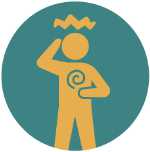'Qigong' for Emotional
Release and Grounding
When emotions build up, it’s easy to feel overwhelmed, scattered, or disconnected from yourself. Anxiety, frustration, and even sadness can weigh heavily—not just on your mind, but on your entire body. Many people assume the solution is to “calm down” or “tough it out,” but Traditional Chinese approaches offer another path: gently moving those feelings through the body until they lose their charge. That’s where qigong and similar practices come in.
Simple Grounding Practices to Try Today
1. Breathe into your belly
Place both hands over your lower abdomen. Inhale slowly through your nose, letting your belly rise. Exhale gently. Repeat for 2–3 minutes. This centers your attention and calms your nervous system.
2. Gentle arm circling
Stand with feet shoulder-width apart. Inhale as you slowly lift your arms out and up. Exhale as you let them float back down. Move with your breath for 6–10 cycles. This qigong movement helps release emotional tension.
3. Mindful walking
Take a short walk outside. As you walk, notice the feeling of your feet touching the ground, the movement of your arms, and the rhythm of your breath. Let your mind rest in the experience of walking itself.
4. Soften the shoulders
Sit or stand quietly and check in: Are your shoulders tense or lifted? Let them drop. Breathe into the sensation of letting go. Even small shifts can release accumulated stress.
5. Name the feeling
Silently name the emotion you feel—“anxious,” “angry,” “sad.” Naming it without judgment often reduces its intensity and helps you return to a grounded state.
Qigong (pronounced “chee-gong”) is an ancient Chinese method of movement, breath, and attention. The word itself means “cultivating life energy,” and its roots go back thousands of years. Unlike strenuous exercise, qigong is slow, flowing, and meditative. It’s not designed to burn calories or build muscle—it’s designed to restore inner balance. In many ways, it’s like a moving meditation. You breathe deeply. You slow your mind. And your body starts to let go.
What makes qigong especially powerful for emotional wellness is that it recognizes emotions as part of our internal energy system. In this view, emotions like anger, fear, or worry can become “stuck” in the body—creating tension, fatigue, or even illness over time. The simple act of moving gently and breathing with awareness helps clear that stagnation. For example, circling the arms while inhaling and exhaling slowly can calm the nervous system, regulate the Heart, and settle the spirit. You don’t need to know the Chinese names for the movements. You just need to do them slowly, with care, and without judgment.
Of course, qigong isn’t the only way to feel grounded. Sitting quietly with your hands over your lower belly and simply breathing can be equally effective. In TCM, this lower region—called the “dantian”—is the body’s energy center. Placing your attention there pulls you out of your spinning thoughts and anchors you in the moment. Even slow walking outdoors, especially in nature, can have a grounding effect. The key is to bring attention to your breath, your feet, and the physical sensations of being alive—something we often forget when emotions take over.
Meditation, too, is part of this approach. But you don’t need to sit on a cushion or silence your thoughts completely. One helpful method is called “embodied awareness”—just noticing where your emotions live in your body. Is your chest tight? Are your shoulders raised? Can you soften them a little? This kind of noticing—not fixing, just noticing—can release tension more deeply than you'd expect.
Sometimes emotions come in waves. The goal isn’t to suppress them but to let them move without letting them sweep you away. Qigong, mindful breathing, and grounding exercises give you tools to do just that. They don’t require a belief system or a fitness level. They just ask for presence, patience, and a willingness to feel better.
In a fast-moving world, these practices offer a gentle reminder: You are not your anxiety. You are not your fear. You are the space that holds them—and that space can be calm, clear, and deeply steady.




